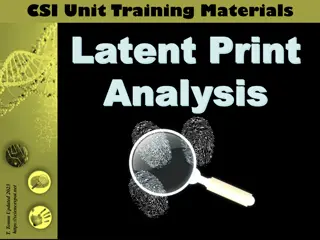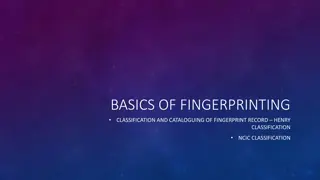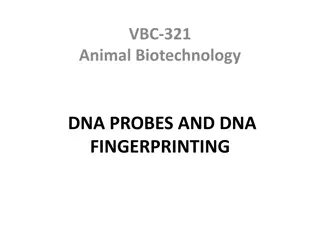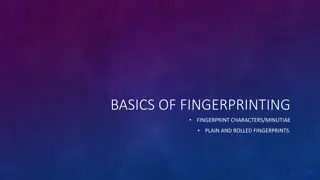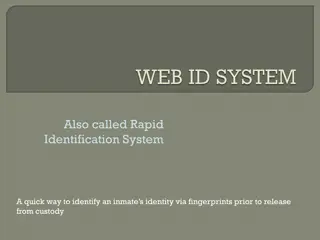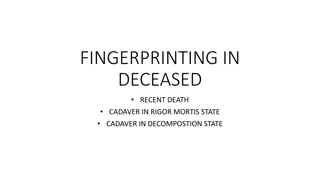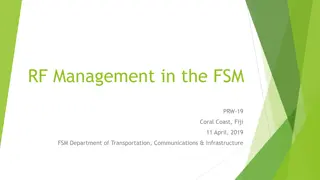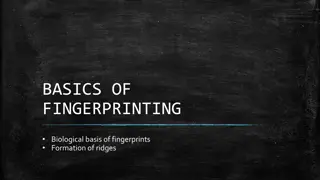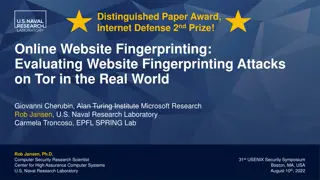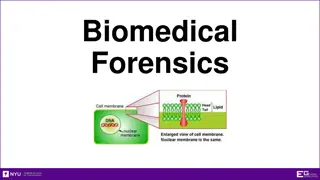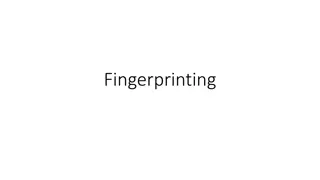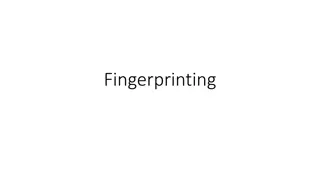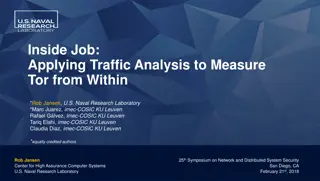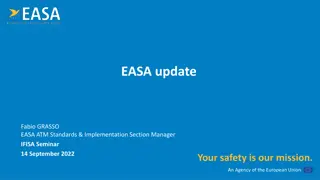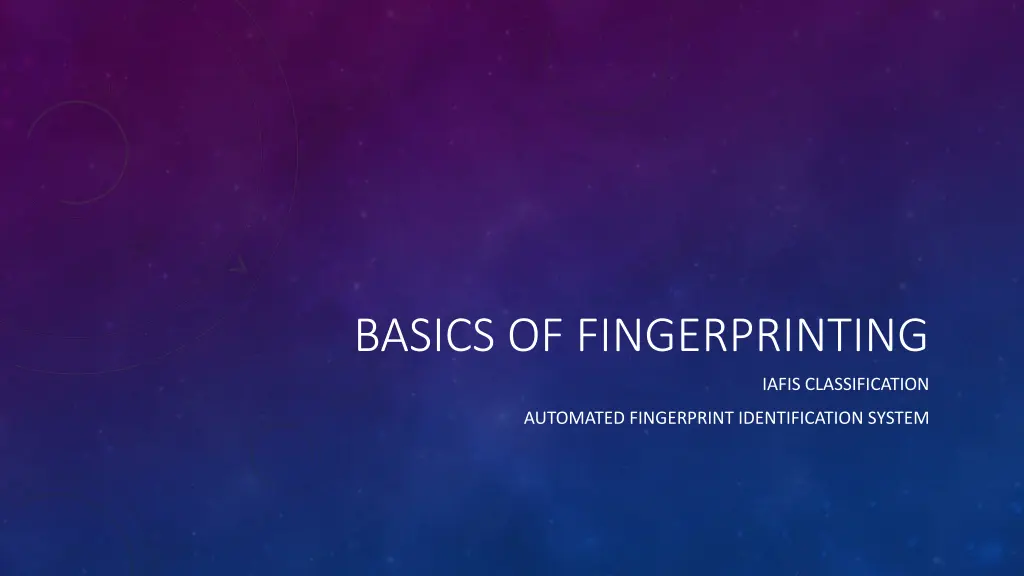
Fingerprint Identification System Overview
Explore the basics of fingerprinting, IAFIS classification, and the Automated Fingerprint Identification System (AFIS). Learn about the designations in IAFIS, the operation of the AFIS subsystems, and the capabilities of AFIS in criminal identification and investigation. Discover how AFIS can search known fingerprints, latent prints, and more, as well as its integration with other biometric identification technologies.
Download Presentation

Please find below an Image/Link to download the presentation.
The content on the website is provided AS IS for your information and personal use only. It may not be sold, licensed, or shared on other websites without obtaining consent from the author. If you encounter any issues during the download, it is possible that the publisher has removed the file from their server.
You are allowed to download the files provided on this website for personal or commercial use, subject to the condition that they are used lawfully. All files are the property of their respective owners.
The content on the website is provided AS IS for your information and personal use only. It may not be sold, licensed, or shared on other websites without obtaining consent from the author.
E N D
Presentation Transcript
BASICS OF FINGERPRINTING IAFIS CLASSIFICATION AUTOMATED FINGERPRINT IDENTIFICATION SYSTEM
IAFIS CLASSIFICATION IAFIS (Integrated Automated Fingerprint Identification System) designations, are based on fingerprint patterns. Require two characters per finger Twenty characters on a line.
PATTERN DESIGNATION
AUTOMATED FINGERPRINT IDENTIFICATION SYSTEM Came into existence in late 19th century. Automatic fingerprint identification is based on digital representation of the fingerprints. Can run search of a million records in under a minute Law enforcement AFISs are composed of two interdependent subsystems: tenprint (i.e., criminal identification) subsystem latent (i.e., criminal investigation) subsystem.
Tenprint subsystem is tasked with identifying sets of inked or livescan fingerprints incident to an arrest or citation or as part of an application process to determine whether a person has an existing record. An automated tenprint inquiry requires a minutiae search of only the thumbs or index fingers. Submitted fingerprints have sufficient clarity and detail to make searching of more than two fingers unnecessary. Latent print or criminal identification subsystem is tasked with solving crimes though the identification of latent prints developed from crime scenes and physical evidence. The search of a latent print is more tedious and time-consuming than a tenprint search as they are fragmentary and of poor image quality.
WHAT AFIS CAN DO Search a set of known fingerprints (tenprints) against an existing tenprint database (TP TP) and return with results that are better than 99% accurate. Search a latent print from a crime scene or evidence against a tenprint database (LP TP). Search a latent from a crime scene against latents on file from other crime scenes (LP LP). Search a new tenprint addition to the database against all unsolved latent prints in file (TP LP).
OTHER FUNCTIONS Addition of palmprint records to the database to allow the search of latent palmprints from crime scenes. Interfacing of AFIS with digital mug shot systems and livescan fingerprint capture devices. Addition of hand-held portable devices for use in identity queries from the field. The query is initiated by scanning one or more of the subject s fingers, extracting the minutiae within the device, and transmitting to AFIS, which then returns a hit or no-hit (red light, green light) result. Hit notification may be accompanied by the thumbnail image of the subject s mug shot. Multimodal identification systems, including fingerprint, palmprint, iris, and facial recognition, are available.
WORKING OF AFIS Fingerprint Indexing Fingerprint Matching Fingerprint Acquisition Match Verification Feature Extraction Quality Estimation Fingerprint Enhancement Feature Editing
FINGERPRINT ACQUISITION Data acquisition: the fingerprint to be recognized is sensed. Scan the inked card, lift, item, or photograph. Digital images acquired by this method are known as off- line images. Acquisition through a livescan digital fingerprint image directly from a finger without the intermediate use of ink and a paper card. Sensors: Optical frustrated total internal reflection (FTIR), Ultrasonic reflection, Thermal sensing of the temperature differential (across the ridges and valleys), Quality index of 0.9 considered as good quality prints and 0.2 is classified as very poor quality print.
Fingerprint images from (a) Livescan- FTIR based optical scanner (b) Livescan capacitive scanner (c ) Livescan Piezoelectricscanner (d) Livescan Thermal Scanner (e) Off-line inked impression (f) Latent print
FINGERPRINT INDEXING In an identification system, multiple comparisons may be needed. S Stored representations in the database are partitioned into bins, based either on information extrinsic to the sensed input measurements (e.g., sex and age of the individual) or on information intrinsic to the sensed image (e.g., fingerprint class or type) As a result, the input fingerprint need not be searched in the entire database, but only in the particular bin of interest.
FINGERPRINT ENHANCEMENT Computerized fingerprint feature extractors require image pre-processing or enhancement to improve perceptibility. Two major types of problems: image contrast adverse physical factors such as scars, blurs, creases, sweat pores, and incipient ridges. Fingerprint image enhancement aims to minimize the undesired effects caused by such elements in order to extract a sufficient number of reliable features, namely, minutiae and fingerprint singularities (cores and deltas).
FEATURE EXTRACTION A machine representation (pattern) is extracted from the sensed image. Fingerprint representations can be broadly categorized into two types: global and local. Global representation: used for fingerprint indexing. Example : Class, location of critical points (e.g., core and delta), Ridge count Local representation : used for fingerprint matching. Example :pores on the ridges, or salient features derived from the ridges ( minutiae). In AFIS, only two most prominent types of minute details are used for their stability and robustness: (1) ridge ending and (2) ridge bifurcation.
Representation of RE and RB Minutiae Extraction Algorithm
FINGERPRINT MATCHING Machine representations alone are not considered a sufficient basis for assessing the matching outcome. A fingerprint expert relies on subtle and complex reasoning to argue whether two prints originated from a single finger or two distinct fingers. Given two (test and template) representations, the matching module determines whether the prints are impressions of the same finger. The matching phase typically defines a metric of the similarity between two fingerprint representations. It also defines a threshold to decide whether or not a given pair of representations belongs to the same finger (mated pair).
DECISION MAKING The comparison yields a matching score quantifying the similarity between the two representations. If the score is higher than a threshold, (determined by the system operating point) the representations are determined to have originated from the same fingers.


